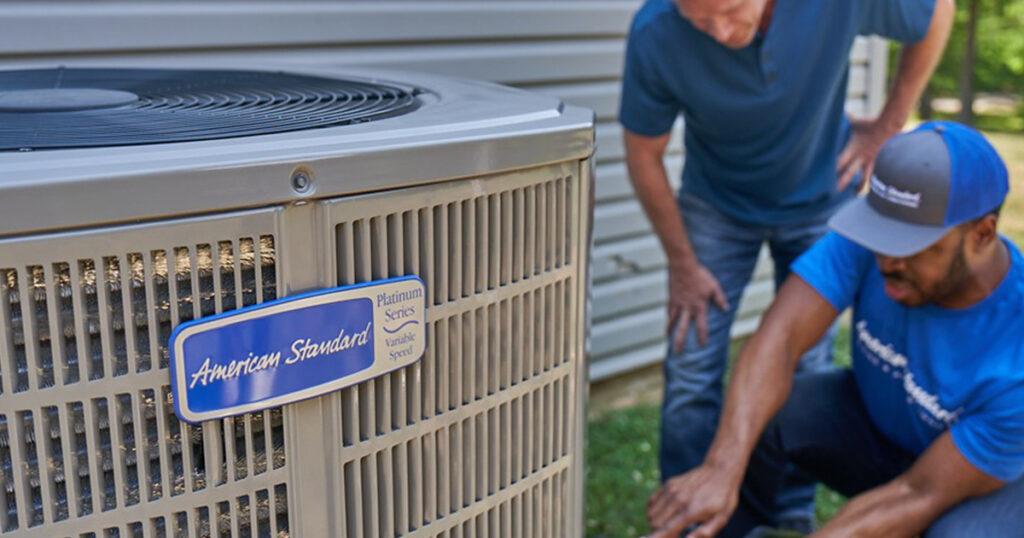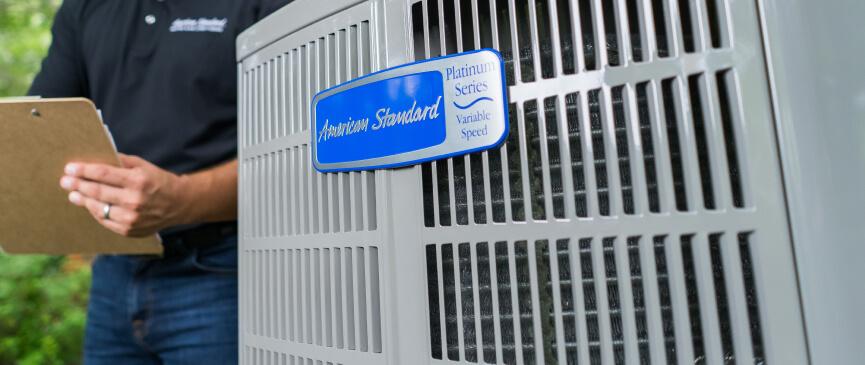How to Choose the Best Energy-Efficient AC Unit for Your Home
Learn what questions to ask yourself and HVAC companies when it’s time to replace your central air conditioning system.

By Anne Fonda
Whether you have an aging split AC unit that struggles to cool your home, or your AC repair bills are sky high and coming more frequently, there comes a time when you need to face facts. It’s time for AC replacement. Or maybe your central air conditioner died, and the HVAC repair guy said buying a new, energy-efficient air conditioner would be more cost-effective.
You have a lot of options when it comes to buying a new energy-efficient AC condenser unit. How do you make the best choice for your comfort and your budget, even when you have limited time?
You can start by asking some questions. Do your research to find the information you need to make the right choice. Working with an experienced HVAC professional can make a big difference in how satisfied you are with the air conditioning system and the installation. In this article, we’ll go over:
Ready? Let’s get started.
A properly sized AC unit with the correct cooling capacity is critical to your long-term comfort and energy savings.
A unit that’s too big will cool too quickly without properly dehumidifying the air. This can leave you feeling cold and clammy and can waste energy through short cycling. A unit that’s too small may run longer trying to reach your set temperature. This can lead to decreased comfort and higher energy bills.
The best way to get a properly sized system is to work with an HVAC professional who performs the Manual J calculation. This involves looking at much more than the square footage of your house to offer a precise central AC unit size recommendation. Be wary of an HVAC company that simply looks at the size of your existing air conditioner and says that’s the size you need.
If you want an estimate of how many tons your new AC unit should be, you can use the AC unit tonnage per square foot estimation table below. But know that it is not as accurate as the Manual J load calculation.
You should know that capacity is measured in tons, and that one ton = 12,000 BTUs (British Thermal Units).
| Home size (sq. ft.) | Unit Size (tons) | Unit Size (BTUs) |
| 1,200 sq. ft. | 2-ton AC unit | 24,000 BTUs |
| 1,500 sq. ft. | 2.5-ton AC unit | 30,000 BTUs |
| 1,800 sq. ft. | 3-ton AC unit | 36,000 BTUs |
| 2,100 sq. ft. | 3.5-ton AC unit | 42,000 BTUs |
| 2,400 sq. ft. | 4-ton AC unit | 48,000 BTUs |
| 3,000 sq. ft. | 5-ton AC unit | 60,000 BTUs |
The tons per sq. ft. estimator has evolved over the years, so if you get two estimates recommending different-sized units, ask to see the HVAC dealer’s calculations and have them explain them to you.
SEER2 stands for seasonal energy efficiency ratio. It measures an AC or heat pump unit’s average cooling efficiency over an entire cooling season, with temperatures ranging from 65°F to 104°F. The higher the SEER2 rating, the more efficient it is at cooling. We sell units ranging from 13.4 to up to 23.6 SEER2.
EER2 stands for energy efficiency ratio. EER ratings measure a cooling unit’s efficiency at 95°F. The higher the EER2, the more efficient the unit is at cooling during extreme temperatures. Ask your dealer what a unit’s EER2 is if it’s not listed.
Both ratings matter. EER2 may matter more if you live in a hot climate where temperatures routinely reach the 90s and 100s for days at a time.
Our most energy-efficient AC unit, the AccuComfort™ Variable Speed Platinum 20 Air Conditioner, has a SEER2 of up to 23.6 and an EER2 of up to 14 for cooling efficiency even in extreme heat. An energy-efficient air conditioning system will keep you in cool comfort for years to come, while potentially lowering your utility bills.
Learn more about HVAC terms for energy efficiency.
What’s the difference between a variable-speed AC unit, a multi-speed unit, and a single-stage unit?
In general, the more speeds or cooling stages a central air system has, the more energy efficient the air conditioner is. A single-stage unit has one speed, so it has a lot of starts and stops, which can use a lot of energy. At the other end of the spectrum, a variable-speed unit has longer run times at lower speeds, using less energy to provide more precise temperature control.
Get the full story about the differences between the stages and speeds.
You may or may not be aware that, due to new regulations, the HVAC industry has transitioned to a new refrigerant in residential air conditioners and heat pumps. The new refrigerant is R-454B, and it has a lower global warming potential (GWP) than R-410A.
The transition started at the beginning of 2025, so while new units use R-454B, older units still in inventory use R-410A. What does this mean for you and your choice?
R-410A units
R-410A units may or may not be available in the size and efficiency you want, as inventory dwindles. In addition, as R-401A refrigerant is being phased out, it will be harder to come by in the event you need an AC recharge. However, an R-410A unit may be available at a lower price as dealers try and move older inventory to allow space for newer models.
R-454B units
Think of R-454B units as the newest model car. They use the latest technology, can be more efficient, and of course, are better for the planet because of the low GWP. R-454B will be more plentiful than R-410A as the new refrigerant will continue to be produced.
Learn more in our homeowner’s guide to HVAC refrigerants.

How much does a new central AC unit cost?
The cost to replace an AC unit will vary depending on the energy efficiency, cooling capacity, and much more. Ballpark figures for AC unit replacement cost range between $8,800 for a base unit and $20,000+ for a high-efficiency AC unit.
For the full story, read our blog How Much Does a New AC Unit Cost? But the best way to get an accurate cost of a new AC unit is to get estimates from local HVAC companies.
What is the cost of a new furnace and AC unit?
You may decide to replace your furnace at the same time if yours is old and not compatible with the new air conditioner you want. Your furnace and AC unit replacement cost will depend mainly on the energy efficiency of the units and the number of heating and cooling stages.
Replacing your heating system at the same time as your cooling system is more cost-effective than replacing the central air conditioner now and waiting a year or two to replace the furnace. For accurate pricing, contact your local American Standard dealer.
HVAC financing and incentives
Paying for a new HVAC system can be expensive. The good news is that qualifying systems are eligible for tax credits and rebates to help lower the cost. In addition, you may be eligible for special 0% HVAC financing through a participating Customer Care dealer.
In general, a central air conditioning unit will last about 15 years. Proper installation and regular AC unit maintenance can help the air conditioner last longer. Conversely, shoddy installation and a lack of maintenance can shorten the lifespan of your central air conditioner. The climate where you live and how often you use your air conditioner play a part in how long an AC unit should last, as well.
How long can AC units last?
It’s not common, but we know of homeowners who have been able to cool their homes with central AC units that are 20+ years old. However, keep in mind that the older an air conditioner gets, the less efficient it is, and the more expensive it can be to repair, as it can be hard to find compatible parts or the right refrigerant.
How long do AC units last in Florida?
Floridians run their air conditioners hard. The air conditioning runs for more of the year than in many places, and for more hours each day. Add to that the high humidity, and air conditioning systems wear out faster than they do in other parts of the country. Expect a central AC unit to last 10-15 years. Higher-quality American Standard air conditioning systems with good maintenance will last longer.
How long does an AC unit last in Texas?
Texas is a big state with different climates. For example, Houston can be hot and humid while Amarillo can be dry and cooler in the summer. Depending on what part of the state you live in and how often you run the air conditioning, an AC unit can last from 10-15 years. Again, proper installation and regular AC maintenance can prolong the life of the system.

Who should I hire for my AC unit replacement?
When replacing a home AC unit, who you hire is critical to your comfort for years to come. You want to hire a company that will do the work required to properly size your air conditioning system, offer a variety of central AC units to choose from, do a quality installation, and partner with you on AC maintenance.
Not sure who to work with? Check out our blog on finding the best HVAC service near me.
When we say our HVAC equipment is built to a higher standard, we mean it. Our product design teams and systems engineers put in countless hours to bring you durable, reliable, and energy-efficient heating and cooling systems.
Some specifics:
- Air conditioners are made in the USA, at our Tyler, Texas manufacturing plant.
- Products undergo the equivalent of 5 years of operation in 16 weeks of testing under harsh weather conditions in our SEET lab.
- The American Standard Home App gives you control from the palm of your hand.
- A system paired with an American Standard smart thermostat opens the way for remote monitoring and remote diagnostics, allowing your dealer to spot small problems before they become big ones, even when you’re away from home.
- Industry-leading registered limited warranties of 10 years on the compressor, outdoor coil, and parts, and 10 years on the indoor coil.
- Special 0% HVAC financing available through participating dealers.
Work with HVAC professionals you can count on
For over a hundred years, we’ve made some of the most awarded, well-engineered heating and air conditioning equipment and earned a reputation for doing things right. You can count on American Standard and our network of Customer Care dealers to listen to your needs and provide energy-efficient solutions that fit your budget.
Anne Fonda
Content Writer, Trane Technologies
A Content Writer with Trane Technologies, Anne Fonda researches topics and writes for Trane® and associated residential HVAC brands. She works in collaboration with Trane Technologies subject matter experts, offering easy-to-understand, informative content on complex topics. Her goal is to help consumers make informed decisions on the products and services they need.
She has written for HVAC and other service provider websites for over 16 years. Before transitioning to web content writing, Anne had a 14-year stint as an award-winning journalist. She graduated cum laude from the University of Missouri-Columbia School of Journalism.
When she’s not working, Anne enjoys playing word games, reading, gardening, spending time with family, and visiting gardens and museums.
Expert review by Kimberly Sexton, Senior Systems Engineer



